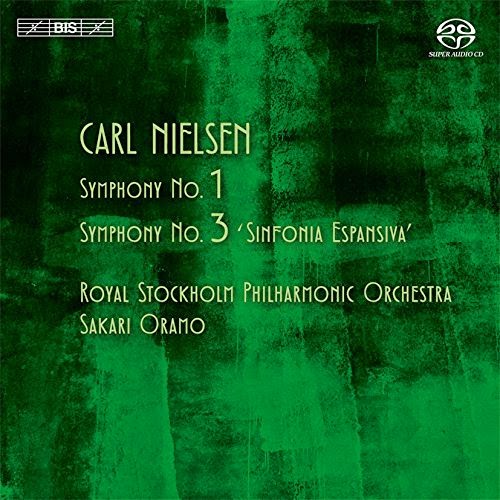Chief Conductor of
the Royal Stockholm Philharmonic Orchestra www.harrisonparrott.com/toursprojects/royal-stockholm-philharmonic-orchestra,
Sakari Oramo, www.harrisonparrott.com/artist/profile/sakari-oramo
continues his cycle of Carl Nielsen
(1865-1931) symphonies on BIS Records www.bis.se
with Symphonies No.1 and 3 ‘Sinfonia
Espansiva’.
 |
| BIS - 2048 SACD |
Following on from his highly recommendable recording of
Nielsen’s fourth and fifth symphonies I came to this new release with great
expectations and was not disappointed.
Sakai Oramo has already shown on his first disc in this
cycle that he has the full measure of the energy that is often needed in
Nielsen. With the opening of the Allegro
Orgoglioso of Symphony No.1 in G
minor, Op.7 he opens at a fine pace, bringing a terrific clarity to the
musical texture. When the tempo slackens there is a fine expansiveness that
provides a fine contrast. There are some beautifully shaped wood wind passages
and, in the slower passages, a great sense of tension. Oramo controls all the
tempi and dynamic changes so well revealing this to be a subtle work, full of
drama and mystery. As the movement progresses one becomes aware of the drama
increasing with every climax. All of the quieter moments are beautifully shaped
and just listen to how Oramo builds slowly from a hushed passage to the brisk
incisive coda. Absolutely terrific.
The Andante flows
gently forward, Oramo bringing a lovely feel to the music with subtle little
rises in dynamics that add so much. He develops a very fine orchestral texture
and a lovely forward moving pulse, building a subtle power to the music. What a
fine Andante this conductor shows this to be, all the while keeping taut powerful
strings behind the musical flow.
Oramo brings out the subtle lightening of mood of the Allegro Comodo - Andante Sostenuto - Tempo
I still taut, observing every dynamic and soon letting the orchestra surge naturally
to a climax. There is so much pent up energy that Oramo occasionally lets loose
as well as many lovely details revealed in the quieter, slower moments. The Royal
Stockholm brass bring some lovely sonorities towards the end.
The Finale. Allegro
Con Fuoco is full of fire and power, yet kept really taut with Nielsen’s
quiet little moments beautifully shaped. Oramo reveals every little detail and nuance.
When the music really builds centrally, with some fine woodwind flourishes, he
brings a directness that is refreshing. When he later builds another fine
climax it is offset by a quite exquisite gentler passage before leading to a
terrific coda where Oramo really lets the Royal Stockholm players have their
head.
This is an exceptional performance which made me feel as
though I was re-discovering this symphony all over again.
Just as Nielsen’s Symphony No.4 ‘The Inextinguishable’ was in
the composer’s own words ‘…the elementary will of life…life is unquenchable and
inextinguishable…music is life and, as such, inextinguishable…’ so with his Symphony No.3, Op.27, ‘Sinfonia Espansiva’ the
first movement, Allegro Espansivo
‘…was meant as a burst of energy and life affirmation…’ Nielsen’s opening
staccato chords quickly lead into a glorious flowing theme, an unstoppable
outpouring of melody and invention which Oramo picks up on, revealing Nielsen’s
strength and energy. There are lovely harmonies and soon a brooding passage where
Oramo again finds a confined power with very taut playing from the Royal
Stockholm Philharmonic. There are some fine woodwind passages with Oramo
finding wonder in the little details of the quieter moments. Midway, a waltz
rhythm appears to which Oramo brings an underlying feeling of menace before the
rhythm is allowed to break out powerfully. Later Oramo doesn’t miss the related
rhythm in a slow, quieter section. As the music becomes more dynamic and the
drama increases, this conductor shows how aware he is of the overall architecture
of the music before some terrific sweeping passages take us to the coda.
Horns open the Andante
Pastorale with some fine, subtle playing as the hushed strings join, full
of expectancy. What an incredible atmosphere Oramo conjures up, letting the Royal
Stockholm woodwind unfold beautifully. The orchestra’s searing strings do not
hold back as they bring an emotional outpouring, showing just a little bit of
portamento. Drama tries to break out before baritone Karl-Magnus Fredriksson
enters over a lovely orchestral backdrop followed by soprano Anu Komsi with
their wordless vocal sonorities lending almost orchestral texture to the music.
Horns sound before woodwind weave a lovely tapestry in the Allegretto un poco, soon interrupted by
Nielsen’s schizophrenic sudden disruptions. Oramo brings out all of Nielsen’s
little orchestral details as well as his sudden changes of direction. He develops
all of this with Nielsen’s tremendous overlaying of textures before, towards
the end, the woodwind bring a wistfulness reflected by the whole orchestra.
The Finale. Allegro
moves off with a broad, stirring theme from the strings with Oramo bringing a
terrific sweep, full of the sense of arrival as the music appears to have
overcome all difficulties. There is a lovely ebb and flow before the woodwind
and pizzicato strings bring a more playful section. The confident music returns
full of power and resolution, beautifully judged right through to the coda
where the horns lead before the whole orchestra brings a very fine resolute
conclusion.
This is another extremely fine performance from Oramo and
his terrific players.
Oramo brings a terrific assurance to these works, finding so
many fine details and a sense of re-discovery. There is a very fine recording
made at the Stockholm Concert Hall, Sweden and there are excellent booklet
notes from David Fanning.
These first two releases are the first real rival to Blomstedt’s
San Francisco cycle and look set to be the finest series available. Highly
recommended.
I am looking forward immensely to hearing how Oramo handles
the elusive sixth.
See also:

No comments:
Post a Comment